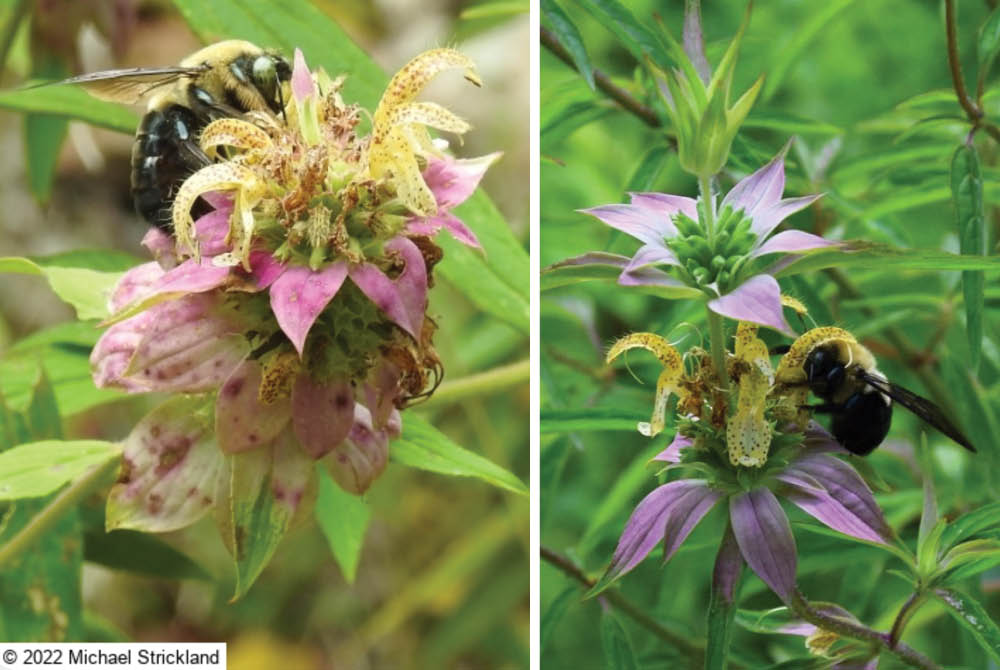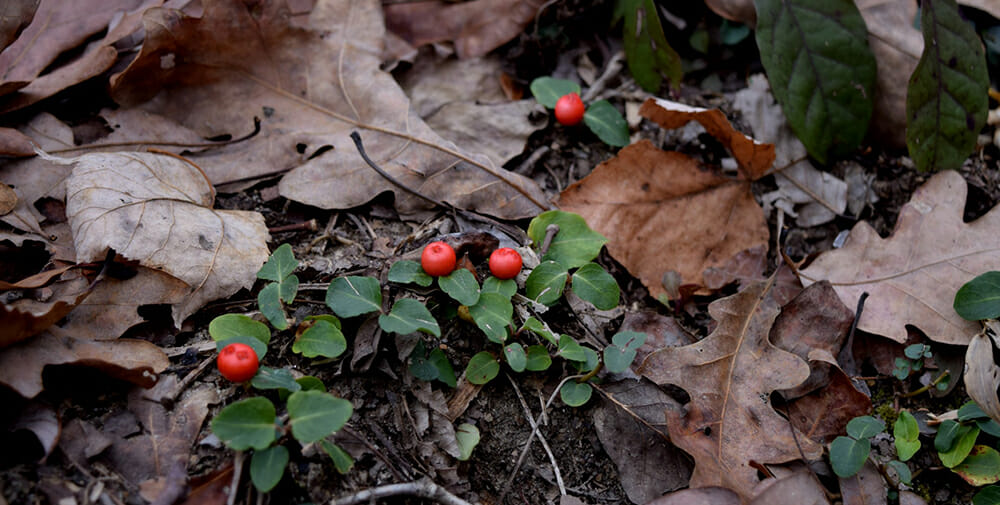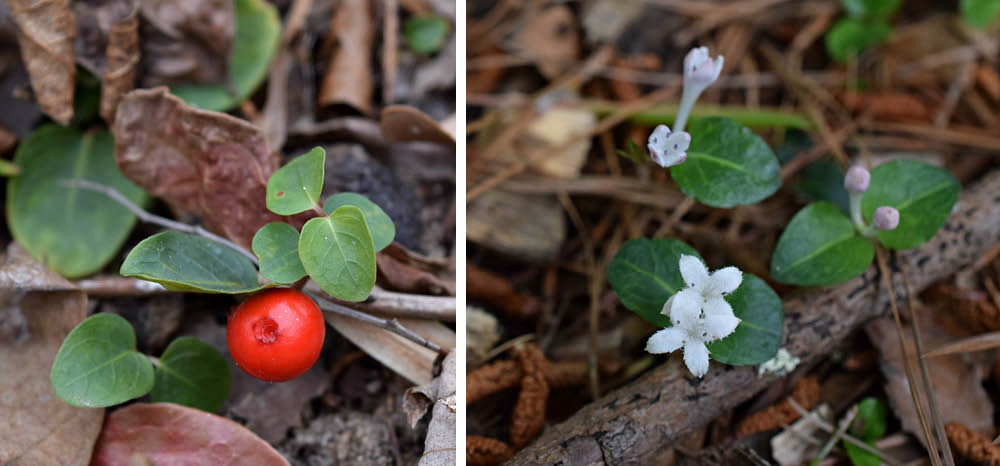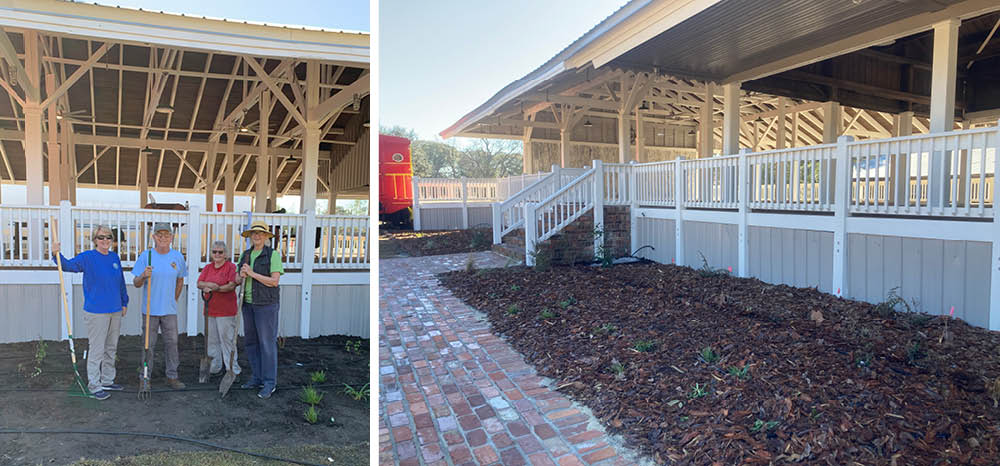
A majority of our members, and quite a few bees, voted spotted beebalm as the GNPS 2023 Plant of the Year. (Photos by Mike Strickland, left and Ellen Honeycutt, right). Read more about this remarkable plant below.
In This Issue ...
- 2022 in review
- Our 2023 Plant of the Year
- Opportunities to contribute to state-level committees
- Spotlight on partridge-berry
- Chapter News
Year-end Summary
In 2022, we watched our chapters grow and host activities throughout the state. We also planned for growth at the state level by starting the process to hire an executive director. While GNPS members and volunteers will always be our most important asset, the Board recognizes that an executive director can help us grow further and faster, helping GNPS to spread the message about the importance of native plants and habitat conservation to more people in Georgia.
As the year concludes, here we provide a summary of where GNPS is now and some of what we look forward to next year. You, our members, are the reason we exist. We thank you for your support in 2022 and hope that you will continue to be with us in 2023.
Chapter Status
Chapters are the core of GNPS, and we now have seven fully-chartered chapters and one in the final stages of formation. All are active, and just as an illustration of their impact, note that:
- All chapters had at least one educational meeting and their annual business meeting
- 4 chapters held workshops or field trips
- 6 chapters supported workdays for planting or invasive removal
- 7 chapters held plant sales or swaps
- 5 chapters supported plant rescues
- 2 chapters held garden/habitat tours
- 3 chapters received grant funding or significant material donations for projects
- 5 chapters managed restoration sites or certified educational gardens
- 2 chapters provided grants or are organizing fund raising for grants
- 3 chapters held events for the Great Georgia Pollinator Count
- 3 chapters have at least one member on the state board
Chapters provide newsletters and emails targeted to their members. Most of our members have chosen a chapter affiliation. If you haven’t chosen a chapter, ask us how to do that so that you can get newsletters from your closest chapter.
Membership
- We end the year with 1,547 memberships, a 20% increase over the beginning of 2022. We saw a lot of gift memberships this year; thank you to those who decided to share your love of native plants with others!
- We’d love to have chapters in new areas of the state: Rome, Columbus, Albany, and Cumming are just some of the areas that could use folks willing to start a new chapter. We have a fantastic support program for new chapters. If you are interested helping to start a chapter, please email membership@gnps.org.
New Items
- In February, we published our 2022-2025 Strategic plan. If you didn’t get a chance to read it or you’ve joined since then, you can find the details on our website here.
- As part of that plan, we created an advocacy committee to research pro-native plant policies for municipalities and we engaged a team of students at Georgia Tech to help us. If you are interested in volunteering for this committee, send an email to advocacy@gnps.org.
- In our April newsletter, we asked for people to help us put together resources for HOAs. If you’d like to work on developing these valuable resources for our members, please write to us at strategic@gnps.org.
- In an effort to provide a summary of resources for some of the most common native plant-related questions, our July newsletter had an article full of guidance and links.
- The Chapter Council was created, and members from each chapter have met regularly.
- The Stone Mountain Propagation Project (SMPP) has shifted focus toward providing plants for GNPS and other habitat restoration projects. In 2022, SMPP grew over 5,000 pollinator plants for Georgia Audubon in support of a prairie restoration project at Panola Mountain State Park. The Coastal Plain Chapter also continues propagation efforts both to support chapter plant sales and growing species of concern for the Georgia Department of Natural Resources.
Continuing Programs
- Symposium: The 2022 Symposium was held virtually across two sessions on February 19 and 20 and the attendance a testament to how many more people we can reach with virtual events. GNPS partnered with Georgia Audubon for the event. For 2023, we will have the virtual event on February 18 and 19, again in partnership with Georgia Audubon.
- The state level newsletter (you’re reading it right now!) will shift to every other month in 2023. All chapters now provide regular communications to their affiliated members, including newsletters. We will continue to include some chapter news in the state newsletter. Thanks to board member Tom Collins for continuing to be the editor for this newsletter.
- Our online store is available year-round for GNPS swag. You can find plant of the year t-shirts here for the current year (2023 shirt generally not available until February) and the years 2021 and 2022.
Society Financials
As of November 30, GNPS’s total 2022 income was $72,176, with total expenses of $55,313. Membership dues and donations were our primary sources of income. Thank you for your support!
The GNPS Stone Mountain Propagation Project (SMPP) had revenues of $20,053 (including restricted donations) with direct expenses of $9,657. SMPP grows eco-type plants in support of GNPS and its partners’ restoration projects, plus chapter plant sales.
Chapters received $11,684 in direct financial support. GNPS’s insurance premiums increased $3,800 with the expansion of insurance coverage for chapters. $6,100 was invested to enhance our brand through logo designs for GNPS and chapters.
GNPS had cash savings of $213K, which will support planned additional investment in GNPS’s growth, including the hiring of an executive director.
State Board
Thank you to all who voted in our election of the 2023 board of directors. The following new board members are joining in 2023: Chadd Reynolds, Lea Millet, and Les Cane. If you missed the election email, you can read the bio profiles of these new board members by clicking here. We wish to thank departing board members Carling Kirk and Mary Lillian Walker for their service.
Lea Millett has graciously offered to serve as the new board Secretary. We still are on the lookout for a state Treasurer to begin in 2024. Our current Treasurer, Ron Smith, has laid a firm financial foundation crafting policies and procedures that will allow for a seamless transition. Ron wishes to work closely with the incoming Treasurer for a year to ensure this success. If you are interested, please contact us by emailing board@gnps.org.
Thank you for being a member in 2022!
We encourage you to get more active in your chapter; the old adage is still true: many hands make light work. In addition, fresh ideas and perspectives are essential to positive change while the experience of longtime members helps our new ones grow. We need you all.
For those of you with an expiring membership, you should have already received an email reminder; we encourage you to renew. Reach out to the board with any questions or to volunteer: board@gnps.org.
2023 Plant of the Year: Spotted beebalm
Valerie Boss Spotted beebalm (Monarda punctata) is a beautiful and hardy herb, and the GNPS welcomes it as our newest Plant of the Year. A member of the mint (Lamiaceae) family, its natural habitats are woodland margins, sand hills, and coastal plains east of the Rocky Mountains. The genus was named after Nicolas Monardes, a Spanish botanist, whose 3-part book “Historia medicinal de las cosas que se traen de nuestras Indias Occidentales”, written between 1565 and 1574, describes the flora of the Americas. The species name “punctata” means “spotted”, referring to markings on the flower petals.
Spotted beebalm’s most distinguishing feature is its exquisite inflorescence. Flower heads stack atop one another, pierced by the stem, forming a dense spike (cyme) 3-6” long. Each flower head is about an inch around, and consists of a rosette of pink-violet bracts (these can be almost white to vivid violet) capped by a fountain of individual small flowers. Their corollas are double-lipped, with downward arching petals that are creamy yellow and sprinkled with dark purple dots. These dots serve as “nectar guides” to direct insects, particularly bees [1,2]. A whorl of erect, pale green bracts crowns the terminal flower head. Multiple ecotypes of the species exist, so depending on the origin of the seed, flowers may vary slightly in appearance. The flowering season for spotted beebalm is July-September. In autumn, its showy flowerheads morph into dark brown seedheads, filled with tiny seeds.

Flowers may vary in appearance. Note the differences in color and shape of the bracts. (Left and middle photos by V. Boss; right photo by Mike Strickland).
Insects adore spotted beebalm. Its blossoms are a source of pollen and nectar for numerous wasps, including Sphex pensylvanicus, Monobia quadridens, and Ammophila procera; honey bees; specialized native bees, such as Dufourea monardae, Perdita gerhardi, and Protandrena abdominalis; and at least 7 species of butterfly and moth. In addition, native Monardas in general are larval hosts for many moths, including Anterastria teratophora, Lintneria eremitus, and at least 3 species of genus Pyrausta.
Whether hummingbirds feed on spotted beebalm is debatable. Many sources state that members of the genus Monarda attract hummingbirds, but some may not. Monarda is segregated into two subgenera: Monarda and Cheilyctis, distinguished by morphology. Species in the subgenus Monarda (for example, M. didyma and M. fistulosa) are visited by hummingbirds that feed on their copious and accessible nectar. However, the 16 plants in the subgenus Cheilyctis, which includes M. punctata, are less likely to attract hummingbirds because access to the relatively small nectaries at the bases of their corollas is restricted [1].

Left: Fall seedheads are dark brown and button-shaped (photo by Valerie Boss). Right: Flowers in various stages along stem (photo by Ellen Honeycutt).
Spotted beebalm grows to 2-3’ in height. Its stems are erect, 4-sided, simple or sometimes branched, and have soft hairs. Leaves are opposite, hairy, lanceolate, and toothed, growing to about 3” long. Like other members of the mint family, the leaves are pungent and rich in aromatic essential oil, which is medicinal if used with caution. The most abundant compound in spotted beebalm’s essential oil is thymol (50-75%), with lesser contributions from p-cymene, limonene, and carvacrol [3,4]. The concentration of thymol is much greater than that found in other mints, or in aromatic culinary herbs, like oregano. Thymol is antibacterial, and spotted beebalm’s complete essential oil is even better than thymol alone at fighting microbes [3]. Thymol is also toxic, except in very low concentrations. Native Americans historically employed spotted beebalm as a remedy for a variety of ills (detailed information can be found by searching the American Native Ethnobotany Database). Most modern users take it as a very weak tea for respiratory or digestive ailments. The leaves can also be sprinkled on food as a flavoring, but sparingly, owing to their potential toxicity.
Spotted beebalm is an excellent choice for a rock or herb garden. Drought tolerant, it likes plenty of light and well-drained soil, and can handle stony or sandy conditions. Individual plants survive only a few seasons, but they re-seed easily. Grouped in clusters, spotted beebalm catches the eye, as do the myriad insects that thrive on its flowers.
[1] Scora, R. W. (1964) "Dependency of pollination on patterns in Monarda (Labiatae)." Nature 204: 1011-12.
[2] Meeuse, J.D. (1963) The story of pollination, p36-46.
[3] Li, H., Yang, T., Li, F-Y., Yao, Y., Sun, Z.M. (2014) "Antibacterial activity and mechanism of action of Monarda punctata essential oil and its main components against common bacterial pathogens in respiratory tract." Int J Clin Exp Pathol. 7(11): 7389–7398.
[4] Lawson, S.K., Satyal, P., Setzer, W.N. (2021) "The volatile phytochemistry of Monarda species growing in South Alabama." Plants (Basel)10(3): 482
Credits: Text by Valerie Boss. Photos by Valerie Boss, Ellen Honeycutt, and Mike Strickland.
State Committee Openings
Lori Conway
Several of our state-level committees are seeking additional members. Committee work and meetings are largely handled remotely, via email and teleconferencing, so anyone can serve, no matter where you live in Georgia. In fact, we need people from many geographic areas to give our committees a well-rounded view of statewide issues. Member participation on several committees is crucial to shape and accomplish our strategic planning goals that were set last year. We need members for the following strategic planning and standing committees. If you have time and talents that would benefit GNPS, or if you know someone who does, please reach out to us by emailing board@gnps.org.
Advocacy
This committee will research, package and help implement favorable plant policies for municipalities. We currently have engaged an undergraduate capstone design project team from Georgia Tech to perform initial research to guide the work of this committee.
Habitat Corridor
This committee will develop and promote a native plant habitat corridor program that increases awareness of the benefits of adding native plantings. It will help members realize that they are part of the bigger picture, and that they can show other people what they are doing.
Membership/Chapter Relations
This committee addresses member and chapter benefits and oversees the annual process of surveying chapters on their progress and activities. This committee needs a new chair and would greatly benefit from members who have expertise in customer relations management (CRM) software systems.
Finance
The Finance committee provides oversight of the budget and expenditures of GNPS. The committee is chaired by the GNPS Treasurer and meets as needed several times each year.
Education
This committee researches state-level education resources and helps support chapters in their education needs and efforts. As part of the strategic plan, there are three areas of focus: develop an educational pathway to help members with a guided self-education plan, help educate traditional landscaping professionals on effective use and maintenance of native plants, and support chapter-level educational activities.
Symposium
A statewide symposium is held once a year, usually virtually for better reach. This committee helps plan the program, book the speakers, and execute the event.
Scholarship and Grants
For many years, GNPS has periodically provided small grants to people performing native plant research. We also award scholarships to regional native plant conferences (Cullowhee and Florida Native Plant Society) and to the State Botanical Garden’s Certificate in Native Plants to those in need. This committee will establish procedures to award such funds and will meet on an as-needed basis.
Plant Spotlight: Partridge-berry — An Evergreen Groundcover
Ellen Honeycutt

At this time of year, partridge-berry (Mitchella repens) often peeks out among the leaf litter of the forest floor.
Partridge-berry (Mitchella repens) is a tiny subshrub with statewide distribution in forested areas where moisture is good. A member of the madder family (Rubiaceae), it has tiny foliage with rounded leaves in pairs. It is often overlooked in places where it hasn’t spread much, but when it is abundant, it is quite attractive. While most often a low-growing plant of 2 inches, the Flora of the Southeastern United States indicates that in maritime forests it can achieve heights of over 7 inches.
Pairs of pinkish-white flowers have four petals each and bloom in May. They are considered lightly fragrant for those able to get low enough to smell them! Both flowers must be pollinated in order to produce a single fruit between them; twinberry is another common name for this plant. If you look closely at the fruit, you’ll see two spots on the surface, a lingering reminder of the two flowers whose ovaries fused to create it.

Left: Fruit of partridge-berry (Mitchella repens). Right: Paired flowers in various stages of blooming.
Flowers require cross-pollination and native bumblebees visit them in search of nectar. Fruits are primarily eaten by birds including “Ruffed Grouse, Bobwhite Quail, Wild Turkey, and the now extinct Passenger Pigeon” (source). Small mammals such as chipmunks and mice eat them as well.
Look for this tiny plant on your winter hikes in moist forests. Often a berry or two is still visible, the bright fruit color helping us to notice this small plant.
Chapter News

Amy Heidt, Paul Sumner, Heather Brasell, and Mary Alice Applegate installing the GNPS Native Plant Education Garden at the Alapaha Station Depot.
Coastal Plain Chapter
With a lot of encouragement by CPC member Heather Brasell, a GNPS-approved educational garden was recently completed as part of a city renovation project. The Alapaha Rail Depot was built in 1881 in the center of Alapaha, Georgia. It was recently renovated to be used for community events. The area on both sides of the depot platform needed landscaping, providing CPC member Heather Brasell with a good opportunity to coordinate with the local town council and establish a GNPS-approved Native Plant Educational Garden.
The site was prepared by digging to loosen compacted soil to a depth of at least one foot and some topsoil was added to level the site. A variety of native plants were provided by the Coastal Plan Chapter, donated by chapter members or purchased from Superior Trees in Lee, Florida.
CPC members Amy Heidt and Mary Alice Applegate helped with the landscape design. Correctional personnel helped plant the garden areas, then Paul Sumner installed an irrigation system. Alapaha town employees spread pine bark mulch donated by the local Dupont sawmill. This project has entailed a lot of teamwork involving CPC and local citizens. The garden installation was completed in time for the official open house on December 10. It will be maintained by a team of local volunteers.
Fringed Campion Chapter
Our big news item of the season is the award of a $5,000 Downtown Challenge Grant from the Community Foundation of Central Georgia. We are honored to be chosen for funding so that we can bring native plants to downtown Macon. Be on the lookout in early 2023 for opportunities to volunteer to help with this new project.
In February, on an exact date to be determined, we will be having a field trip in Oaky Woods, Houston County. See our Facebook page (https://www.facebook.com/FringedCampionGNPS) for a link to sign up for the hike.
North Georgia Mountains Chapter
We are at least somewhat prepared as we head into the new year, with our guest speakers for January and February already lined out: For January we will have Christopher Singer, who helped establish the Live Monarchs Foundation. He will obviously be addressing how monarchs can be helped by installing native plants, sharing some seeds with attendees as well. Our speaker for February is a new chapter member, Don Spence, whose expertise is dealing with tree diseases. Details about both of these will be shared through our chapter emails and the web site.
We are also taking steps towards our native plant sale, which is dwarfed compared to those of some of the other GNPS chapters, but we now have a member that has taken on leadership for the sale, and hope to be able to share details to benefit any of you that head up into the mountains.
Intown Atlanta Chapter
Registration is full for our first event of the New Year, Winter Seed Sowing and Sharing for Native Plants. We look forward to seeing some of you there!
|